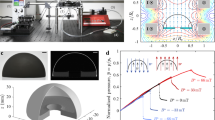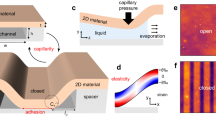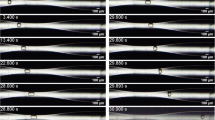Abstract
Encapsulation is a widespread biological process particularly in the formation of protective egg cases of oviparous animals. The egg capsule wall of the channelled whelk Busycon canaliculum is an effective shock absorber with high reversible extensibility and a stiffness that changes significantly during extension. Here we show that post-stretch recovery in egg capsules is not driven by entropic forces as it is in rubber. Indeed, at fixed strain, force decreases linearly with increasing temperature, whereas in rubber elasticity the force increases. Instead, capsule wall recovery is associated with the internal energy arising from the facile and reversible structural α-helix  -sheet transition of egg capsule proteins during extension. This behaviour is extraordinary in the magnitude of energy dissipated and speed of recovery and is reminiscent of strain-induced crystallization in some polymeric fibres and of superelastic deformations associated with diffusionless phase transitions in shape-memory alloys.
-sheet transition of egg capsule proteins during extension. This behaviour is extraordinary in the magnitude of energy dissipated and speed of recovery and is reminiscent of strain-induced crystallization in some polymeric fibres and of superelastic deformations associated with diffusionless phase transitions in shape-memory alloys.
This is a preview of subscription content, access via your institution
Access options
Subscribe to this journal
Receive 12 print issues and online access
$259.00 per year
only $21.58 per issue
Buy this article
- Purchase on Springer Link
- Instant access to full article PDF
Prices may be subject to local taxes which are calculated during checkout




 -sheet transition during straining.
-sheet transition during straining.

Similar content being viewed by others
References
Ma, P. X. & Elisseeff, J. H. Scaffolding in Tissue Engineering (CRC Press, 2006).
Capito, R. M., Azevedo, H. S., Velichko, H. S., Mata, A. & Stupp, S. I. Self-assembly of large and small molecules into hierarchically ordered sacs and membranes. Science 319, 1812–1816 (2008).
Denny, M. W. Biology and the Mechanics of the Wave-Swept Environment (Princeton Univ. Press, 1988).
Rapoport, H. S. & Shadwick, R. E. Reversibly labile, sclerotization-induced elastic properties in a keratin analog from marine snails: Whelk egg capsule biopolymer (WECB). J. Exp. Biol. 210, 12–26 (2007).
Rapoport, H. S. & Shadwick, R. E. Mechanical characterization of an unusual elastic biomaterial from the egg capsules of marine snails (Busycon spp). Biomacromolecules 3, 42–50 (2002).
Tatham, A. S. & Shewry, P. R. Elastomeric proteins: Biological roles, structures and mechanisms. Trends Biochem. Sci. 25, 567–571 (2000).
Gosline, J. M., Denny, M. W. & DeMont, M. E. Spider silk as rubber. Nature 309, 551–552 (1984).
Weis-Fogh, T. A rubber-like protein in insect cuticle. J. Exp. Biol. 37, 889–907 (1960).
Lillie, M. A. & Gosline, J. M. The effects of hydration on the dynamical mechanical properties of elastin. Biopolymers 29, 1147–1160 (1990).
Urry, D. W. et al. Elastin: A representative ideal protein elastomer. Phil. Trans. R. Soc. Lond. B 357, 169–184 (2002).
Shadwick, R. E. & Gosline, J. M. Physical and chemical properties of rubber-like elastic fibres from the octopus aorta. J. Exp. Biol. 114, 239–257 (1985).
Treloar, L. R. G. The Physics of Rubber Elasticity (Oxford Univ. Press, 2005).
Flory, P. J. Theory of elastic mechanisms in fibrous proteins. J. Am. Chem. Soc. 5222–5235 (1956).
Busson, B., Briki, F. & Doucet, J. Side-chains configurations in coiled coils revealed by the 5.15-A meridional reflection on hard α-keratin X-ray diffraction patterns. J. Struct. Biol. 125, 1–10 (1999).
Kreplak, L., Doucet, J., Dumas, P. & Briki, F. New aspects of the α-helix to β-sheet transition in stretched hard α-keratin fibres. Biophys. J. 87, 640–647 (2004).
Fraser, R. D. B., MacRae, T. P., Parry, D. A. D. & Suzuki, E. The structure of β-keratin. Polymer 10, 810–826 (1969).
Vogel, S. Comparative Biomechanics: Life’s Physical World (Princeton Univ. Press, 2003).
Mandelkern, L. Crystallization of Polymers (Cambridge Univ. Press, 2002).
Wollants, P., Roos, J. R. & Delanay, L. Thermally- and stress-induced thermoelastic martensitic transformation in the reference frame of equilibirium thermodynamics. Prog. Mater. Sci. 37, 227–288 (1993).
Liu, Y. & Yang, H. Strain dependence of the Clausius–Clapeyron relation for thermoelastic martensitic transformations in NiTi. Smart Mater. Struct. S22–S27 (2007).
Quillin, M. L. & Matthews, B. W. Accurate calculation of the density of proteins. Acta Crystallogr. D Crystallography D 56, 791–794 (2000).
Rapoport, H. S. Scripps Institution of Oceanography, PhD thesis, Univ. California, San Diego (2003).
Chiou, J-S. et al. The α-helix to β-sheet transition in poly(L-lysine): Effects of anesthetics and high pressure. Biochim. Biophys. Acta 1119, 211–217 (1992).
Feughelman, M. Mechanical Properties and Structure of Alpha-keratin Fibres: Wool, Human Hair, and Related Fibres (Univ. South Wales Press, 1997).
Hearle, J. W. S. A critical review of the structural mechanics of wool and hair Fibres. Int. J. Biol. Macromol. 27, 123–138 (2000).
Schwaiger, I., Sattler, C., Hostetter, D. R. & Rief, M. The myosin coiled-coil is a truly elastic protein structure. Nature Mater. 1, 232–235 (2002).
Root, D. D., Yadavalli, V. K., Forbes, J. G. & Wang, K. Coiled-coil nanomechanics and uncoiling and unfolding of the superhelix and α-helices of Myosin. Biophys. J. 90, 2852–2866 (2006).
Fudge, D. S., Gardner, K. H., Forsyth, V. T., Riekel, C. & Gosline, J. M. The mechanical properties of hydrated intermediate filaments: insights from hagfish slime threads. Biophys. J. 85, 2015–2027 (2003).
Kouzeli, M., Weber, L., SanMarchi, C. & Mortensen, A. Quantification of microdamage phenomena during tensile straining of high volume fraction particle reinforced aluminium. Acta Mater. 49, 497–505 (2001).
Despois, J-F., Mueller, R. & Mortensen, A. Uniaxial deformation of microcellular metals. Acta Mater. 54, 4129–4142 (2006).
Gupta, H. S. et al. Cooperative deformation of mineral and collagen in bone at the nanoscale. Proc. Natl Acad. Sci. USA 103, 17741–17746 (2006).
Paris, O. et al. A new experimental station for simultaneous X-ray microbeam scanning for small- and wide-angle scattering and fluorescence at BESSY. J. Appl. Crystallogr. 40, S466–S470 (2007).
Acknowledgements
We thank B. Shadwick (University of British Columbia, Vancouver, Canada) and F. Zok (Materials Department, UCSB) for helpful criticism. Y. Li (Materials Research Laboratory (MRL), UCSB) and H. Gupta (Max-Planck Institute for Colloids and Interfaces, Golm, Germany) provided critical guidance for WAXS and time-resolved synchrotron experiments, respectively. K. Field (Mechanical Engineering Department, UCSB) helped in developing the microtensiometer. S.W. was financially supported by a California Sea Grant # R/MP-97B and UC BREP GREAT traineeship #2007-02. This work made use of MRL Central Facilities supported by the MRSEC Program of the National Science Foundation under award No. DMR05-20415. C.F.C was supported by an internship from the ‘Research Internships in Science and Engineering’ (RISE) programme sponsored by the MRL and the California NanoSystems Institute (CNSI) at UCSB.
Author information
Authors and Affiliations
Contributions
A.M. and S.S.W. contributed equivalently to this work. A.M. designed and carried out experiments, analysed and interpreted data and wrote the manuscript. S.S.W. designed and carried out experiments, analysed data, contributed to writing the manuscript and wrote the proposal for the UC-BREP GREAT Grant that helped support the work. C.F.C. conducted experiments. J.H.W. wrote the manuscript and edited all portions, checked theory and calculations and was principal investigator of research grants supporting the investigation experiments.
Corresponding authors
Supplementary information
Supplementary Information
Supplementary Information (PDF 244 kb)
Rights and permissions
About this article
Cite this article
Miserez, A., Wasko, S., Carpenter, C. et al. Non-entropic and reversible long-range deformation of an encapsulating bioelastomer. Nature Mater 8, 910–916 (2009). https://doi.org/10.1038/nmat2547
Received:
Accepted:
Published:
Issue Date:
DOI: https://doi.org/10.1038/nmat2547
This article is cited by
-
A bioinspired and hierarchically structured shape-memory material
Nature Materials (2021)
-
Mechano-responsive hydrogen-bonding array of thermoplastic polyurethane elastomer captures both strength and self-healing
Nature Communications (2021)
-
Structure and Mechanical Properties of Gastropod Egg Capsules from Southeast Coast of India
Proceedings of the Zoological Society (2020)
-
Phase transitions as intermediate steps in the formation of molecularly engineered protein fibers
Communications Biology (2018)
-
Toughening mystery of natural rubber deciphered by double network incorporating hierarchical structures
Scientific Reports (2014)



